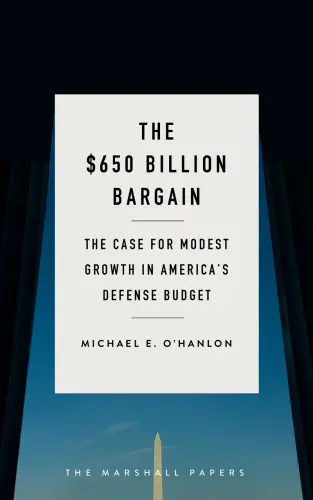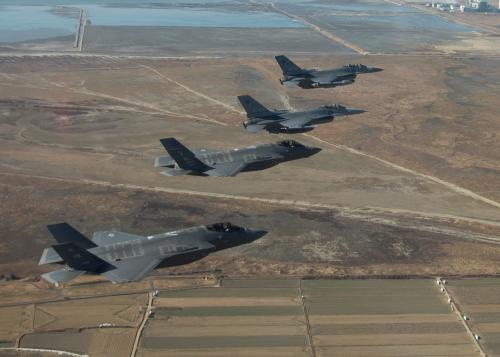Does the new Nuclear Posture Review really lower the nuclear threshold and make nuclear war more likely, as some have contended? Michael O’Hanlon writes that he doubts it, arguing that the authors of the document make it clear they feel just the opposite is true, and given today’s world he thinks they are probably right. This piece originally appeared in USA Today.
To its credit, the Trump administration has just completed and released its third of three major national security documents that will guide U.S. military policy and planning in the years to come. First was the White House’s own National Security Strategy, completed under the guidance of national security advisor H.R. McMaster in December. Then came Secretary of Defense Jim Mattis’s National Defense Strategy, released last month. Together, the two documents focused on the threats posed by Russia and China, as well as the importance of high-tech innovation and the pursuit of greater lethality for U.S. combat forces.
Now comes the administration’s Nuclear Posture Review (NPR), released on February 2. Fittingly, like in the movie Groundhog Day, the plan has some continuity with the Obama administration’s emphasis on wide-ranging nuclear force modernization. But in a break from Obama, it promises to put substantially more money behind that effort. Even more significantly, and controversially, the NPR breaks from previous Obama, Bush and Clinton policy by proposing two different types of U.S. nuclear warheads (which would be done without actual nuclear testing, since the United States continues to respect the 1996 Nuclear Comprehensive Test Ban Treaty). And it suggests that the United States might even consider using nuclear weapons in reply to a non-nuclear attack on its infrastructure or military command and control systems.
Most arms controllers have major problems with this nuclear plan, thinking that it reemphasizes nuclear weapons at a time we should be trying to reduce their visibility and profile in international affairs, and that it lowers the U.S. nuclear threshold by introducing more situations where American first use of nuclear weapons might be contemplated.
But does this new NPR really lower the nuclear threshold and make nuclear war more likely? I doubt it. The authors of the document make it clear they feel just the opposite is true, and given today’s world I think they are probably right.
Russia has been developing new nuclear capabilities of late, and talking of a doctrine of “escalate to deescalate.” By this hare-brained scheme, Moscow would use one or a few nuclear weapons, perhaps against isolated military targets, in a future war (perhaps fought over the security of a Baltic state like Latvia or Estonia) in the hope of intimidating the United States and its allies into rapid capitulation. We need to signal to Moscow that it does not own this space of limited nuclear war, by making clear we might respond in kind. Having smaller-yield nuclear weapons (fairly easy to create without testing, just by reducing some of the nuclear explosive materials in existing warheads) could help reinforce this kind of deterrence and signal firmly to Vladimir Putin that no such Russian strategy of limited nuclear warfighting would work.
Also, as a study last year by the independent Defense Science Board explained, current U.S. command and control systems are not well hardened against devastating cyber attack. It is at least conceivable that nuclear control systems, or even the weapons delivery platforms themselves, could be rendered unusable by an enemy’s cyber attack. American critical national infrastructure like electricity grids is similarly vulnerable. No enemy should think that it could get away with a debilitating attack against much of the U.S. economy, or its crucial military deterrent forces, without risking severe retaliation. Given Mattis’s steady hand at the Pentagon, I do not really think we would use nuclear weapons lightly or cavalierly. The new doctrine that would consider a nuclear response against a large-scale cyber or infrastructure attack is an in extremis option that would almost certainly never be invoked — but that adversaries should have to worry about, so that they won’t consider any such attacks against us.
However, the NPR does have one big problem. It overestimates badly the amount of money that will likely be available for nuclear modernization in the years ahead. Calling nuclear modernization the nation’s top military priority, it demands that some $1.2 trillion be spent over the next two decades modernizing five elements of our nuclear forces: the submarine force, the bomber force, the intercontinental ballistic missile (ICBM) force, the nuclear weapons production complex itself, and the nuclear command and control infrastructure.
We need to do some of this, to be sure. Our submarine force carring nuclear-tipped ballistic missiles is aging; we need to replace it to keep our forces reliable, and the people operating them safe. Our bomber force is too small for the many conventional military missions it is called to perform; buying the new B-21 bomber should be a top defense priority, and because it is dual-purposed, we will get more effective nuclear deterrence from it too. And finally, the nuclear command and control system does need to be improved and hardened, especially against cyber attack.
However, we do not need major new production capacity for our nuclear warheads, which remain extremely reliable by all accounts (the nation spends more than $10 billion a year monitoring them and refurbishing key parts when necessary). And the “Minuteman” ICBM force, while aging itself, can be extended into the future with a combination of modest upgrades and modest downsizing of the force (the latter step would free up some existing deployed weapons to be used as test missiles, prolonging the Minuteman’s reliable life). We can remain at our current force level of just over 1,500 strategic warheads (the same total as Russia’s) by allocating more warheads to the submarine or bomber force.
So in the context of the upcoming defense budget proposal by the Trump administration, we need to take a hard look at how money would be spent by this nation on its nuclear forces (and other parts of the U.S. armed forces). There will not be enough money to do everything — especially in an era of nearly trillion-dollar annual federal budget deficits.
But in its main emphasis of pushing back against aggressiveness by other major powers, Russia in particular, the Trump administration gets the essence of its nuclear policy right. Hopefully this will not need to be a permanent change to U.S. nuclear posture. But the main decisionmaker on that front will be Moscow, not Washington. And until the Russians resume more responsible nuclear behavior, we need to play some of the same game they are playing, too.



Commentary
Trump’s nuclear plan mostly makes sense
February 6, 2018